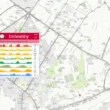Microplastics are minute plastic fragments that are less than five millimetres long and are produced during the manufacturing of commercial products as well as during the breakdown of bigger plastics. Microplastics pose a pollution risk to both the environment and animal health.
Everything is becoming contaminated by widespread microplastic, which may be found in food, drink, air, and even human beings. Microplastics have recently been discovered in large quantities in both food and drinking water. A 2019 study found that one individual ingests about 1,769 microplastic particles daily, including through fruits and vegetables. The average apple we eat has 195,500 microplastic particles per gramme, whereas the average carrot has over 100,000.
According to the report, the number of microplastics along the shore is alarmingly rising. One gramme of sand had almost 300 microplastic particles, indicating the extremely high degree of pollution throughout the shoreline.
Concerned about the toxic pollution levels, the researchers then looked closely at the food chain. “An examination of the typical man’s diet served as the basis for the research. It sought to count the amount of tiny plastic particles in the widely consumed hot beverage doodh patti “In the past, Hina Moin, a researcher at Jinnah University for Women, examined the sand at Clifton Beach.
“Tea samples were collected from different areas of the city. The samples were found to be contaminated with microplastic,” Moin said. “Since doodh patti tea is consumed in 100 to 250 milliliter cups, about 100 to 1,250 microplastic pieces enter our body with each cup.”
The researcher further said that they have not found any significant difference in microplastic contamination in the samples obtained from different areas of Karachi because the tea-sellers everywhere use the same raw material: tea leaves, milk and sugar, and the preparation method is the same.
“The presence of significant amount of microplastic in doodh patti tea is a cause of concern and more research is ongoing in this regard,” she added.
Muhammad Moazzam Khan, Technical Adviser for WWF-Pakistan, also said that the presence of microplastic in doodh patti tea samples is alarming.
According to him, “the chemical makeup of each microplastic particle relies on the chemical makeup of the basic plastic, its usage, and its breakdown.” “The particles’ surface has the capacity to absorb environmental toxins. These microplastic particles may be hazardous and dangerous if these pollutants and substances are, and their presence in human food may be damaging to people’s health “Then Khan.
Khan said that tests for microplastics are still being conducted all across the world. The majority of experts believe that microplastics themselves are probably not hazardous, but the chemicals that build up on their surface may be damaging to human health, he continued.










